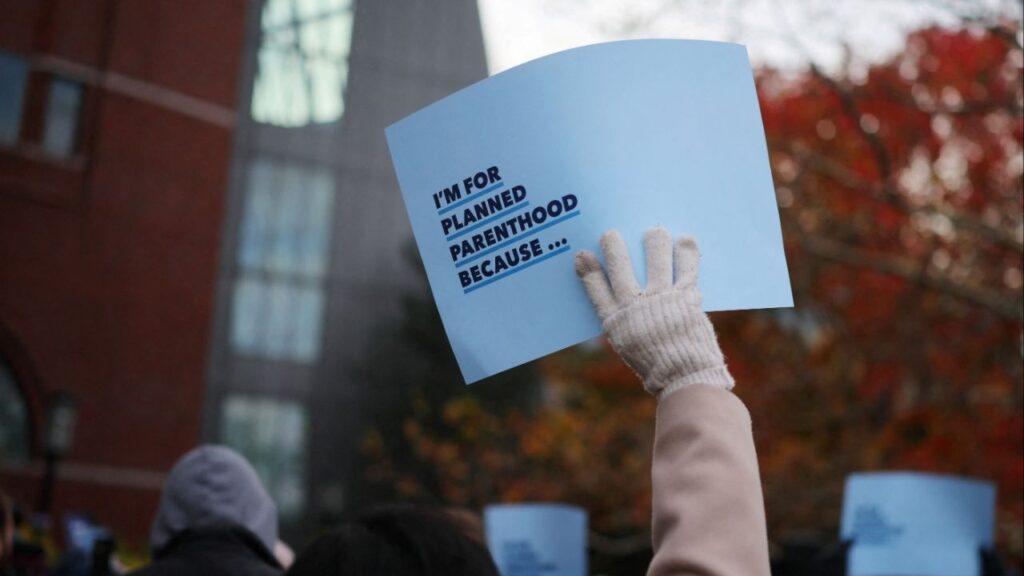Share
|
Getting your Trinity Audio player ready...
|
A couple of years ago, I was sitting in the cafeteria of a homeless facility in the Midwest with the facility’s director. As I was observing people walk in and out, I asked the director a question: “Are the people in here representative of your homeless population?”

Matthew Dildine
Opinion
My friend responded, “Yes, why do you ask?”
I explained to him that while I certainly saw people who needed help, I didn’t see many of those guys who looked completely gone mentally or those guys who I saw around my city streets that looked like extras from The Walking Dead. Frankly, I didn’t see people who looked….as bad.
His response: “Oh you are from California. You have a much bigger drug problem.”
We all can remember a time when California didn’t look the way that it does now. Homelessness in California was declining up until 2014. In fact, for the seven years before 2014, homelessness in California was declining by more than double the national average.
But around 2014 something changed. While nationally homelessness continued to decline (although not in every U.S. city), California experienced the most rapid growth of homelessness in U.S. history and continues to break records year over year.
What Went Wrong in California?
So what happened? Was it because housing was cheaper or more affordable then? While prices were lower, I am not sure I can remember a time in the last 15 years when I would label real estate in California as anything but expensive. Certainly, the major California cities where we continue to see the most homeless (Los Angeles, San Jose, San Francisco) have never been considered affordable.
Was it because of income inequality? Before 2014, the minimum wage was less than $8 and while it has gone up in recent years, homelessness has as well.
Was it because rents were lower? Again, they were lower but I am not sure anyone making minimum wage could ever afford an apartment in Los Angeles or the Bay Area. Moreover, when we look at other major (expensive) U.S. cities such as Chicago, Houston, and Miami which saw rents increase over the last 10 years by 24%, 32%, and 35%, respectively, those same cities also experienced a decrease in homelessness by 20%, 57%, and 9%.
Does lack of affordable housing, low wages, COVID, and high rents impact homelessness? Of course. The point is that those conditions have been around for decades and cannot by themselves account for the dramatic increase California has experienced.
So, what did change? What intervening event happened around 2014 that turned seven years of positive growth into seven years of disaster?
Passage of Prop. 47 Helped Create Drug Crisis
Two important things happened around 2014. First, voters passed Prop. 47 which essentially decriminalized drug possession and paved the way to make it much easier to distribute drugs. Talk to any police officer and they will tell you that drugs have exploded on the street. They are cheaper to get, more readily available, and the law is only making the problem worse.
Meth is incredibly addictive, potent, and dangerous. Being on meth makes a person seem like they are going through a bipolar or schizophrenic psychosis. Moreover, it takes upwards of two years to truly even have a shot at being free of a meth addiction. That’s why 90-day programs are so unsuccessful. The drug is still in someone’s system at 90 days. Prop. 47 without a shadow of a doubt has contributed to the incredible proliferation of drugs on the street. Here is an example of how:
There is a car in a housing complex down the street from one of our facilities. The car is owned by a well-known drug dealer, someone we have had to prohibit from eating in our cafeteria because he sells to our other clients. Prop. 47 allows him and the other individuals roaming the streets of downtown on bikes with backpacks to keep a minimal amount of drugs on them. When they sell their drugs, they just go get more. If they get caught, all they get is a misdemeanor which, of course, they never receive because the police know that is a toothless, pointless lost cause. Who can blame them?
Before Prop. 47, we had a waiting list of a couple hundred people wanting to get into our life rehabilitative programs — some of whom were arrested for drug-related crimes. Today, that list is much shorter. Prop. 47 removed the incentive for some people to get help. Before Prop. 47, drug intervention programs through the courts had hundreds of people going through them locally where help was mandated. Today, they are rarely used.
It’s no wonder CVS and Walgreens are fleeing California as fast as its residents. Before Prop. 47, the police could arrest someone high and allow them to spend a few nights in jail coming down or possibly require them to attend drug court or a drug intervention program. Now that same high person might be given a citation, if anything, and instead of being forced to come down off a high, is out committing property crimes to feed the next high.

‘Housing First’ Puts More People on the Streets
Since the passage of Prop. 47, the price of meth once over $10,000 per pound has dropped approximately 85% and now doses in the Central Valley can be purchased for as little as $5. In San Francisco in 2020, there were more than double the amount of deaths related to drug overdoses as there were because of COVID-19. What was San Francisco’s response? Require masks and hand out needles, literally.
People talk frequently about mental illness causing homelessness and undoubtedly it is a major cause. Meth, however, is such a dangerous, addictive, and potent drug now being laced with things like fentanyl, that it is creating a whole new classification of people who are mentally ill. I am no longer sure where the line is between a person who was born with some sort of severe mental disorder and a person whose brain is gone simply because they have used meth for two years.
The second intervening event that occurred around 2014 (2016 to be precise) is that California became the first State to go all in on a policy known as “Housing First.” Housing First is an approach to address homelessness that believes in providing direct access to permanent housing with no requirement for sobriety, mental health treatments, a job, or the participation in any sort of program or services. It theorizes that the way to solve homelessness is to give everyone a home and once in a home, try and provide optional supportive services. Services or sobriety are not required.
Since adopting this strategy two things have occurred in California: (1) no state has invested more money in the Housing First strategy, and (2) no state has experienced an increase in homelessness like California. In fact, since adopting its Housing First policy, California has seen a 50% increase in people sleeping on the street.
After Housing First was adopted, funding that was once going to drug treatment programs or facilities that provided housing coupled with addiction services evaporated almost overnight. Just to recap, California passed Prop. 47, which created a huge drug problem and then it took away funding for drug rehabilitative programs diverting the money to housing programs that provided no requirement for a participant to seek any form of treatment.
Sounds like California, right?
San Francisco Is Poster Child for What Not To Do
If providing housing — even supportive housing — was the solution that could solve all our problems you would think that San Francisco would be the model city. From 2005 through 2019, no city provided more permanent supportive units than San Francisco on a per capita basis. In 2006, it had about 2600 people sleeping on the street. Over the next 10 years, the city added 3,809 additional transitional or permanent housing units which, in theory, could have provided a home for every homeless person. Yet, it didn’t ease the problem.
During the same period that San Francisco doubled the number of housing units available to the homeless, its homeless population almost doubled. Why? It could be because solving homelessness involves much more than giving someone a house. Quite possibly it could also be because San Francisco had already become a haven for drugs before the passage of Prop. 47. The city was essentially the test case for what the rest of California would become.
When a director for the National Alliance to End Homelessness was asked hypothetically, “What if we provided 100,000 apartment units to 100,000 homeless individuals? Would they be replaced by another 100,000 people on the street? His response was, “…definitely….”
The tide against Housing First’s one-size-fits-all approach is beginning to turn. Recently, Harvard University completed a 14-year study of the homeless placed into a Housing First model. It is the longest and most comprehensive study to date. What they found is that after 10 years, only 12% of the homeless remained housed. Forty-five percent died.
Even HUD, which continues to champion Housing First, has admitted in its research reports that the “provision of housing does not result in substantial improvement to mental health or substance-related disorder.” It’s no wonder that once a person goes beyond the 12-month mark after being placed into a housing unit, keeping a person housed is a challenge.
The Cato Institute also recently published a study that challenged the so-called “evidence” behind the claimed “evidence-based approach of Housing First. The study found that across the nation, Housing First communities were frequently experiencing increases in homelessness.
Increasingly, there is a growing narrative around the U.S. and, more importantly, in California that Housing First communities are not doing well because they simply do not have the supportive services they claim to have. Los Angeles has invested more money in Housing First than any city in America. Yet at the Conference of Mayors in Washington D.C. this past year, Mayor Karen Bass, expressed the need for more options than simply Housing First. She has launched the Inside Safe Initiative, which provides a diversity of options, but that has been viewed as an affront to the Housing First model.

Housing First: The Cash Cow
Now, what if we provided a permanent supportive unit to every homeless person in California? What would be the cost? According to UC Berkeley, the average permanent supportive housing unit costs $480,000 (which still seems low to me). But for argument’s sake, using that amount and California’s belief that the way to solve homelessness is to give every homeless person a unit, the total cost based on the current homeless population would be more than $76 billion. That is more than the overall state budgets of 45 states! And, that $76 billion doesn’t include the necessary support staff needed to provide services to those 160,000 new residents.
However, that $76 billion price tag sounds pretty good to a lot of people. The reason is that Housing First has become a profit center for many developers and private individuals. Make no mistake about it – people are making a profit off of Housing First. It is a cash cow.
I have nothing against making a profit. Businesses can help us solve our social issues. The problem is that this machine keeps turning and those profits are not always going back into helping people. They are … profits. While there are certainly some very altruistic businesspeople, what also has occurred is that developers purchase hotels and create or use low-resourced or shell non-profits that end up running the sites that offer minimal services while they cash in on the lease or voucher income. As the State Attorney General’s Office has discovered in the Bay Area and Los Angeles, this also creates a ripe environment for corruption and misuse of funds.

California Jumps the Shark
The state Legislature recognized that we needed to build housing or facilities faster. Projects were routinely slowed down or stopped altogether by expensive and time-consuming environmental reviews, zoning changes, and attacks from angry neighbors.
It passed a series of laws that allow projects to serve the homeless to be streamlined, bypassing many of the environmental, zoning, and entitlement processes — so long as the project is Housing First. Although I do not agree, I can understand government-funded projects having this requirement given that all government dollars must apply to Housing First.
But if I am building a project that is privately funded, takes no money from the government, and applies different (but successful) methodologies other than Housing First – say for instance a facility focusing on addiction — why can’t I enjoy the same streamlined benefits as state-funded projects? My choices are to either fit into the narrow rigid box of Housing First or absorb the time, expense, and risk associated with California’s red tape-wrapped entitlement and environmental process. It is a policy so crazy that it only belongs in California.
Why is it not OK to tell a mother with a child that is addicted to meth and has trouble acting as a responsible parent that she has to participate in a program for the sake of her child?
Why is it not OK to create a sober living environment because some people want to live in an environment with accountability and freedom from drugs?
Why is it not OK to tell someone who has lost the ability to make good decisions for themselves that they have to get help?
Why is it not OK to have housing to help someone achieve personal sustainability without ongoing government support?
Why is it not OK to make a community exclusively for women fleeing some sort of sexual abuse that doesn’t allow men because women need to feel safe?
Why is it not OK to have housing that requires parents to ensure that their children are enrolled in school?
Why is it not OK to tell a husband who is verbally or emotionally abusing his wife, that he has to participate in counseling to try and help save the marriage?
Housing First does not allow for any of these situations. It can be suggested. It can try and persuade. But it cannot be required. The campuses we are building in Fresno will be the most innovative, beautiful, dignified, and collaborative in the state. Our waiting list will be even longer than it is today. Why can’t California support what we do — even if they are not funding it — instead of making it harder?
Ending Homelessness Requires Every Tool in the Box
The increase in people on the streets in California can also be directly correlated with the number of times politicians, local governments, and consulting groups have announced various 4-, 8-, or 10-year plans to end homelessness. There are plenty of 10-year plans around that state that are in year 16. Major problems require major changes, not tweaks with a bunch of money thrown at the problem.
To be clear, we should never stop building housing. And, I am sure that Housing First advocates can provide counter statistics or studies. Undoubtedly, there are examples of projects in the right location, with the right amount of support, and the right type of clients, that have been successful.
However, I believe, we need a diversification of tools available to solve this crisis, including Housing First. When it comes to solving homelessness, there is no silver bullet but today California only has a one bullet gun. Whether that one bullet is Housing First or the methods we use at the Fresno Mission, or any other approach, any policy that tells you it is the only policy is a bad policy.
The bottom line: Prop. 47 and the decriminalization of drugs cannot co-exist with Housing First. It is a recipe for disaster. Better stated, it is the recipe for the condition of California in 2023.
About the Author
Matthew Dildine, a local attorney, is CEO of Fresno Mission, which rescues, restores, and empowers homeless individuals and families. Contact: mdildine@fresnomission.org


















